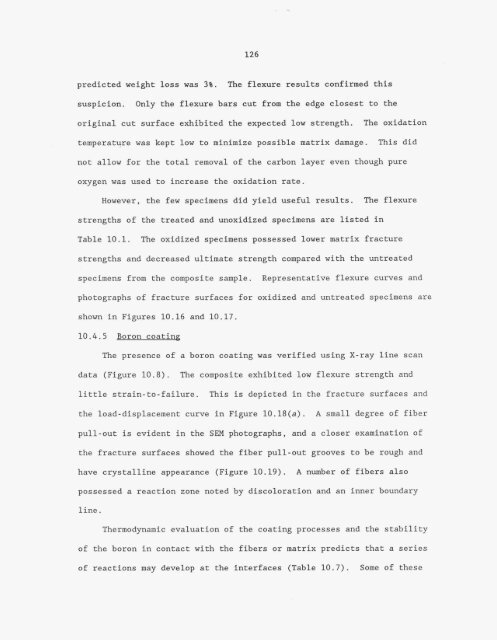Characterization and control of the fiber-matrix interface in ceramic ...
Characterization and control of the fiber-matrix interface in ceramic ...
Characterization and control of the fiber-matrix interface in ceramic ...
You also want an ePaper? Increase the reach of your titles
YUMPU automatically turns print PDFs into web optimized ePapers that Google loves.
126<br />
predicted weight loss was 3%.<br />
The flexure results confirmed this<br />
suspicion.<br />
Only <strong>the</strong> flexure bars cut from <strong>the</strong> edge closest to <strong>the</strong><br />
orig<strong>in</strong>al cut surface exhibited <strong>the</strong> expected low strength.<br />
The oxidation<br />
temperature was kept low to m<strong>in</strong>imize possible <strong>matrix</strong> damage.<br />
This did<br />
not allow for <strong>the</strong> total removal <strong>of</strong> <strong>the</strong> carbon layer even though pure<br />
oxygen was used to <strong>in</strong>crease <strong>the</strong> oxidation rate.<br />
However, <strong>the</strong> few specimens did yield useful results. The flexure<br />
strengths <strong>of</strong> <strong>the</strong> treated <strong>and</strong> unoxidized specimens are listed <strong>in</strong><br />
Table 10.1.<br />
The oxidized specimens possessed lower <strong>matrix</strong> fracture<br />
strengths <strong>and</strong> decreased ultimate strength compared with <strong>the</strong> untreated<br />
specimens from <strong>the</strong> composite sample.<br />
Representative flexure curves <strong>and</strong><br />
photographs <strong>of</strong> fracture surfaces for oxidized <strong>and</strong> untreated specimens are<br />
shown <strong>in</strong> Figures 10.16 <strong>and</strong> 10.17.<br />
10.4.5 Boron coat<strong>in</strong>e;<br />
The presence <strong>of</strong> a boron coat<strong>in</strong>g was verified us<strong>in</strong>g X-ray l<strong>in</strong>e scan<br />
data (Figure 10.8).<br />
The composite exhibited low flexure strength <strong>and</strong><br />
little stra<strong>in</strong>-to-failure. This is depicted <strong>in</strong> <strong>the</strong> fracture surfaces <strong>and</strong><br />
<strong>the</strong> load-displacement curve <strong>in</strong> Figure 10.18(a).<br />
A small degree <strong>of</strong> <strong>fiber</strong><br />
pull-out is evident <strong>in</strong> <strong>the</strong> SEM photographs, <strong>and</strong> a closer exam<strong>in</strong>ation <strong>of</strong><br />
<strong>the</strong> fracture surfaces showed <strong>the</strong> <strong>fiber</strong> pull-out grooves to be rough <strong>and</strong><br />
have crystall<strong>in</strong>e appearance (Figure 10.19). A number <strong>of</strong> <strong>fiber</strong>s also<br />
possessed a reaction zone noted by discoloration <strong>and</strong> an <strong>in</strong>ner boundary<br />
l<strong>in</strong>e.<br />
Thermodynamic evaluation <strong>of</strong> <strong>the</strong> coat<strong>in</strong>g processes <strong>and</strong> <strong>the</strong> stability<br />
<strong>of</strong> <strong>the</strong> boron <strong>in</strong> contact with <strong>the</strong> <strong>fiber</strong>s or <strong>matrix</strong> predicts that a series<br />
<strong>of</strong> reactions may develop at <strong>the</strong> <strong><strong>in</strong>terface</strong>s (Table 10.7). Some <strong>of</strong> <strong>the</strong>se

















